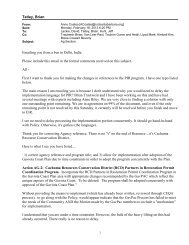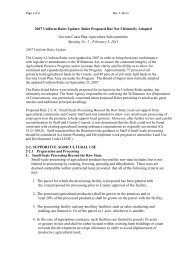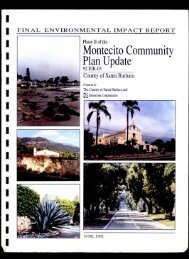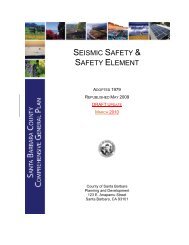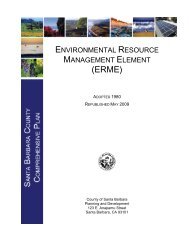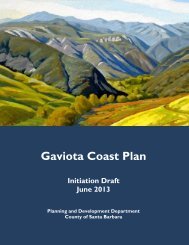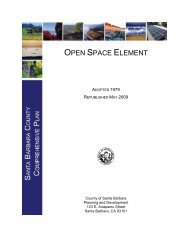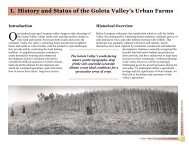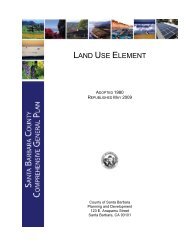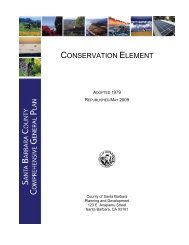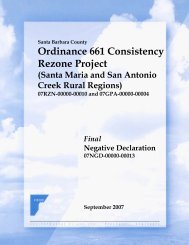Tier I - Long Range Planning Division - Santa Barbara County ...
Tier I - Long Range Planning Division - Santa Barbara County ...
Tier I - Long Range Planning Division - Santa Barbara County ...
Create successful ePaper yourself
Turn your PDF publications into a flip-book with our unique Google optimized e-Paper software.
Compliance Manual <strong>Santa</strong> <strong>Barbara</strong> <strong>County</strong> Permit Coordination Program<br />
Agency Mandates That Can Affect One Conservation Project<br />
Regulatory Mandate Agency Involved<br />
Section 404 Clean Water Act<br />
Federal Endangered Species Act<br />
2<br />
Environmental Protection Agency<br />
Army Corps of Engineers<br />
United States Fish and Wildlife Service<br />
National Marine Fisheries Service<br />
National Historic Preservation Act State Historic Preservation Office<br />
National Environmental Policy Act Federal Agencies<br />
Section 401 Clean Water Act<br />
Regional Water Quality Control Board<br />
Porter Cologne Act<br />
California Coastal Act<br />
California Coastal Commission<br />
Coastal Zone Management Act<br />
Fish and Game Code Section 1602<br />
California Department of Fish and Game<br />
California Endangered Species Act<br />
California Environmental Quality Act State and local agencies<br />
Erosion and Grading Ordinances,<br />
<strong>County</strong> government<br />
Development Standards, Environmental<br />
Protection Ordinances, and Local Coastal<br />
Plans<br />
The results of the conservation projects implemented under the Elkhorn program were<br />
dramatic. Between 1998 and 2006, 50 projects were completed, 50% more than was<br />
originally projected. More than 60,000 tons of sediment were prevented from entering<br />
the Elkhorn Slough, its tributaries, and the Monterey Bay National Marine Sanctuary,<br />
and more than two miles of stream bank and channel were restored or revegetated. In<br />
addition, the program brought NRCS into cooperation with many farmers who had not<br />
previously expressed interest in on-farm conservation. The results originally anticipated<br />
– more conservation projects, a broader range of projects, and better quality projects –<br />
were met and exceeded.<br />
1.2.2 Evolution of Permit Coordination<br />
Following the success of the Elkhorn project, similar permit coordination programs have<br />
now been established in other areas along California's coast, including the Morro Bay<br />
watershed, <strong>Santa</strong> Cruz <strong>County</strong>, Humboldt <strong>County</strong>, Alameda <strong>County</strong>, Marin <strong>County</strong>, the<br />
Salinas River watershed, the Navarro River watershed, and the upper Pajaro River<br />
watershed. The most recent programs established are for <strong>Santa</strong> <strong>Barbara</strong> <strong>County</strong> and San<br />
Luis Obispo <strong>County</strong>.<br />
While all these programs followed the same original blueprint, they all have turned out<br />
differently. The best outcome for any program is to end up with a complete set of<br />
programmatic permits from all the regulatory agencies that affect a project. In reality,<br />
this outcome is a rarity: most of the programs have had difficulties obtaining one or<br />
more permits from regulatory agencies. Reasons for inconsistencies among programs are<br />
not well understood, but seem to be related to individual staff preferences rather than a<br />
given agency‟s policy. Support from local county government is especially important<br />
because it also reflects support from the Coastal Commission. Most coastal counties<br />
have adopted Local Coastal Programs for projects implemented in the coastal zone in<br />
order to comply with the Coastal Act, but the Coastal Commission generally defers to




